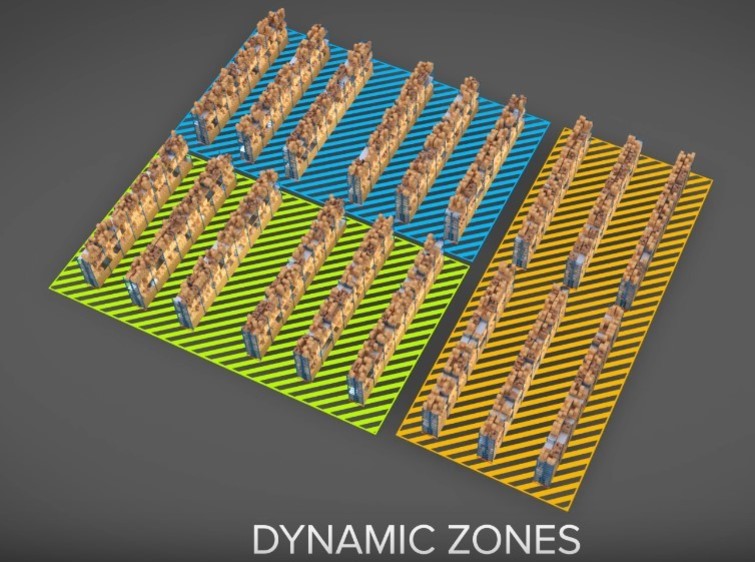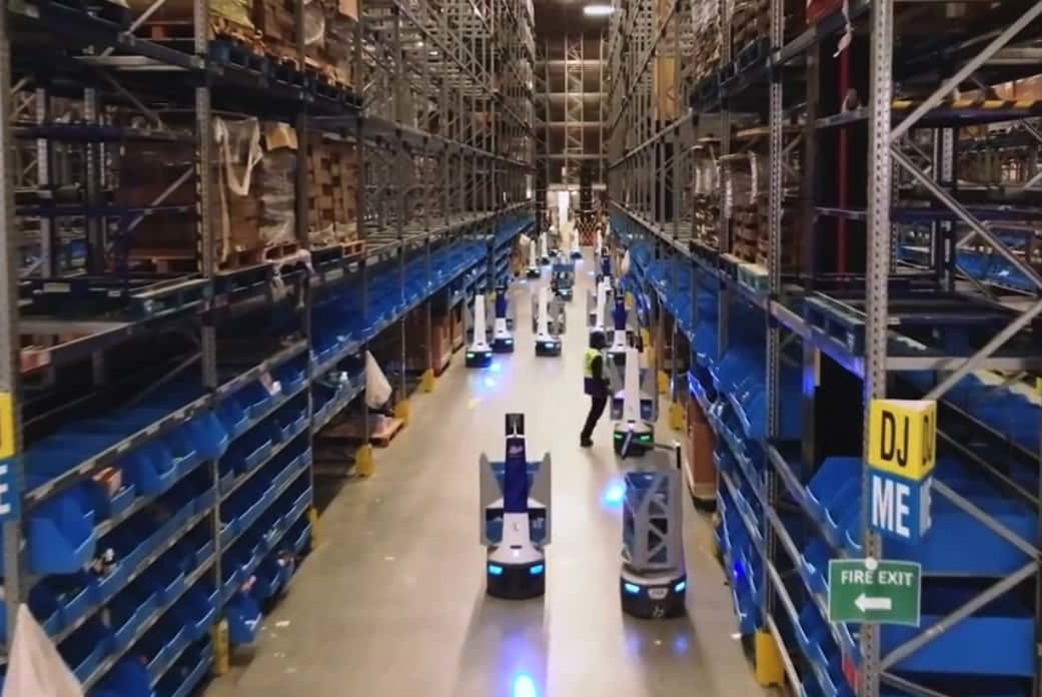Warehouse Design – Autonomous Mobile Robots - Cobots + Swarmbots
Posted on 18th July 2022
In the previous Blog - Autonomous Mobile Robots (AMR’s) – “Goods to Man”, the introduction stated that for a variety of reasons including:
availability of labour,
labour costs,
social distancing,
Covid safe methods of working,
increased online sales
that we will continue to see increased use of automation in warehouse operations.
We also stated that the picking operation in a warehouse generally accounts for more than 60% of the total labour hours, and as a result we are seeing highly efficient automated picking solutions including “Goods to Man” concepts becoming more popular.
This subject for this Blog is Autonomous Mobile Robots - Cobots & Swarmbots.
What is an AMR?
An AMR is a robot that moves around a warehouse independently and takes instructions from Warehouse Control / Execution Software (WCS / WES). The robots are fitted with sensors, scanners and 3d cameras. They navigate through buildings using digital maps routing from point A to B. The robots can avoid obstacles and can interact safely with humans. Changes to operational layouts can quickly be implemented and new maps learned.
The two most popular Autonomous Mobile Robots types are:
Goods to Man Systems (such as the Amazon Robotics / Kiva system)
- robots pick up and deliver shelf units (pods) to operators who work at static receipt and pick stations. (See previous Blog)
Collaborative Robots (Cobots)
- Cobots that are self-guided around a warehouse, the pickers work in dynamic zones and the Cobots move between the zones.
The basic operation design assumptions described within this document are the same for Cobots as for Swarmbots. The differences between the two concepts will be explained in the Swarmbots section of this Blog.
What is a Collaborative Robot?

Cobots are robots intended for direct human robot interaction within a shared space, or where humans and robots are in close proximity. Cobots applications contrast with traditional industrial robot applications in which robots are isolated from human contact (e.g. the Amazon Kiva system).
We will consider Cobots that interact with warehouse operators to perform put away, pick, replen and counting tasks. Two of the current leaders in this technology are 6 River Systems, who supply Cobots, and Locus Robotics who supply Swarmbots.
Overview of Cobot Operations
In very simplistic terms the Cobots are directed around a warehouse by the control system to perform a variety of tasks through 3 distinct area – Induct, Picking/ Processing and Take-off.
Induct
At the induct area an operator will be directed to scan onto the Cobot the picking units (these can be a mix of bins, totes, trays or cartons). The system determines the size of the pick units based on volumes and weights. The system allocates a unique order or pick reference to each unit.
Following induct the system directs the Cobots to the first dynamic zone. The system intelligently groups orders to minimise walking and increase productivity. The system will also allocate pick units of a variety of sizes based on order cube. The control system interleaves tasks in a zone to maximise efficiency. The tasks allocated can consist of some or all of the following:
Picks
Replenishment
Putaway
Returns
Cycle Counts
The system looks to utilise any spare operator capacity in low pick periods with non-pick related tasks, and when required will revert back to pick tasks.
The system determines the most suitable grouping of orders based upon the SKU’s to be picked and the associated pick locations using an algorithm.

Locus Induct Station
Picking / Activities in work zone
Once the Cobot has been inducted the system navigates the Cobot between “dynamic” zones (the zones expand and contract in real time based on tasks outstanding and the availability of operators. The Cobots operate using a pick and pass system, and the Cobots can navigate through several zones in one cycle.
The Cobots are directed to meet the operator at their last pick location (or to the next pick location), at this point the picker scans his id card. The Cobots are fitted with a tablet display and the screen directs the operators to each task location. At this point, if it is a pick task, the display indicates the location address and displays an image of the items to be picked and displays the pick quantity, item image, description and location.

Locus Tablet Screen
The display can light up to indicate which side of the aisle to pick from and which container to place the item into. The Cobot’s scanner can capture product information, including real-time validation of lot and serial number and allows for hands-free picking.
If another task other than picking is required at this location the relevant instructions are displayed on the screen.
Once the tasks assigned to a work zone are complete the system directs the Cobot to the next operator and the process is repeated. When all of the tasks have been completed the Cobot is directed to the Take Off Zone.
Dynamic Zones
The operators work within a flexible, expandable work area and operate a “pick and pass” methodology. The zones contract and expand in real time, directing the operators to where the actual work is required. The 6 River systems dynamic zones are colour coded below and shows how the zones can change shape and size.

6 River Systems - Dynamic Pick Zones

Take-off
The final stage in the process at is the Take-off point, the pick units are removed from the Cobot can then be sent to a separate pick zone, or an exception area to remove problem orders, or can be transferred to a conveyor for packing. The now-empty Cobot heads back to induct, where the cycle begins again, or if required to the charging station for a battery top up.
Advantages of Using Cobots vs Traditional Picking Operations
The operator learning process is very quick when compared to an operator taking instructions from RF directed WMS terminal.
Efficiency Gains compared to conventional picking operations:
1. Reduced walking with the application of zones significantly reduces the non-value adding walking associated with cart picking.
2. In aisle walking reduced as the system can group “like” orders in order to reduce walking in aisles.
3. Efficiency gains can be achieved by utilising a fixed hands-free scanner and by leading operators to the right location. Also, eliminating the need to push a cart, also helps with efficiency.
The suppliers forecast a 2 to 3 times improvement in operator performance, with a 12 to 18-month payback, these performance gains should of course be validated, and if possible be verified with computer simulation.
An advantage of Cobot solutions when compared to Goods to Person Robots is that they can be implemented into an existing warehouse facility with no layout changes required. Additional robots can be added at any time. Also, if the layout is changed the warehouse maps can quickly be updated.
The Cobots can be purchased outright or rented (subject to a long-term agreement) with the suppliers, and also you can rent additional Cobots during peak periods.
The main advantage of the Cobot systems is the implementation time, from placing an order these systems can go live in 3 to 4 months. Other goods to man systems may take over 12 months in the design and planning stage, before orders for hardware are confirmed. In the current climate of rapid change this is a very long time.
AMR – Collaborative Robots – 6 River systems “Chuck”

6 River Systems Chuck Autonomous Collaborative Robot
A company enjoying great success with their intelligent collaborative robot is 6 River Systems, they have named their Cobot “Chuck”.
The Chucks can operate between an existing rack or shelving system, which means that the integration and go live can be between 2 to 4 months. The technology is now tried and tested and has been deployed in many locations particularly in the US, and more recently in the 3rd party Logistics provider XPO operations based in the UK.
Note: The Chucks can be designed with a variety of different tray shapes / sizes and configurations and can also be designed to carry hanging garments. The maximum weight the Chucks can carry is 90kg.
The Chuck system can also be configured to integrate with their put to light technology in their Mobile Sort solution.

River Systems Cobot – “Chuck”
River Systems Cobot – “Chuck” avaiable in different sizes

River Systems Cobot – “Chuck” available in different configurations

6 Rivers Mobile Sort

Chucks can also be used in conjunction with automated picking robots.
AMR – Collaborative Robots – Locus Robotics

Locus Robotics based by Boston USA suppled 1,000 AMRs to support operations at 12 DHL Supply Chain sites in North America earlier this year. They have also gone live with an operation at a DHL managed site Boots, Burton.
The Locus Cobots are equipped with an integrated power port to allow for the addition of label printers, barcode scanners, RFID sensors and other compatible devices.
So, Why Swarm?
The Locus Cobots operate in a very similar way to the 6 Rivers System; however, the Cobots have a smaller load carrying capacity. The maximum weight the Locus Cobots can carry is 18kg and operate at 1.5m per second – 4 mph. As the Locus Cobots are smaller and more agile robots, they are deployed in greater numbers hence the term “swarm”. The amount of transactions each operator completes on each cycle is reduced, therefore operators move from one Cobot to another more often.
Locus Reports
The Locus software can produce a suite of real-time reporting and metrics including:
lines per hour
pieces per hour
cobot productivity
worker productivity
the reports can be generated as daily, weekly, monthly, or annual reports.
Case Study: DHL Boots Nottingham

There are 135 Locus Cobots deployed at the DHL managed Boots’ warehouse in Burton. They helped process orders of 3 million items over the Black Friday season (21st November to 2nd December 2019).
Warehouse colleagues welcomed the Cobots by giving them names such as Hal, Botty McBot Face.
The system is reported as being a huge success, with efficiency gains reported between 200 to 300%. The operators also enjoyed the fact that each worker’s unique Bluetooth can set the screen automatically to their preferred language.

Locus Operation: Ceva Netherlands
Conclusion
For anyone involved in designing warehouse operations these are very exciting times. The impact of Covid 19 and Brexit has resulted in companies keen to explore new advances in automation. Operator confidence in systems such as AMR’s where there is no single point of failure is high, if a robot breaks down for any reason another robot takes over the tasks.
The main advantage of Cobots and Swarmbots over other AMR’s, and other warehouse automation, is that the existing warehouse does not need to be redesigned. Existing racking and shelving do not need to be modified, and consequently the go live for these types of operations in very quick, possibly 2 to 3 months. These solutions are scalable should additional racks and shelves be added the warehouse the Cobots’ maps can quickly be updated. Also, additional Cobots can be added to the system easily should volumes increase, or to cover short term spikes in activities.
The Cobot systems are generating significant improvements in operator performance. The systems and processes are intuitive and easy to learn. These systems will no doubt become cheaper as more suppliers enter the market and as manufacturing of the robots becomes more efficient.
If you are considering using Cobots in your operations then the analysis of the current operation and assessment of alternative concepts should be assessed by impartial, independent experts. Please do not hesitate to ask for any advice. I would be very happy to provide a quotation to provide any assistance required.
Tagged as: Autonomous mobile robots, Warehouse design
Share this post:
